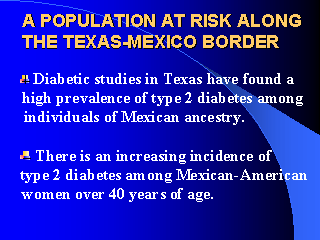|
|
|
|
front |1 |2 |3 |4 |5 |6 |7 |8 |9 |10 |11 |12 |13 |14 |15 |16 |17 |18 |19 |20 |21 |22 |23 |24 |25 |26 |27 |28 |29 |30 |31 |32 |33 |34 |review |
 |
Extensive studies in Texas have found a high prevalence of Type 2 DM among
individuals of Mexican origin or ancestry, with higher rates than those for the
general American population. According to one study, prevalence among Laredo
County Hispanics, who are mostly Mexican-American, was estimated to be 9.5
percent; where as Non-Hispanic Whites in Texas had a prevalence of 2.5 percent.
Prevalence among individuals of Mexican origin in Starr County was calculated to
be 6.9 percent and the highest prevalence was among females in the 55-64 years
age group.
Diabetes Mellitus is a complex disease; its prevention, control and treatment require socioeconomic action and support that are culturally and linguistically appropriate. No particular type of professional health care provider or single individual can effectively tackle the burden of diabetes mellitus in culturally diverse communities. Culturally sensitive interdisciplinary professional networking is needed, in partnership with affected communities to ensure cultural appropriateness for any health care intervention conducted to address the problem/burden of diabetes mellitus.
However, to address the need for a culturally sensitive network of interdisciplinary professional health care providers, I eventually plan to conduct an in-depth literature review, in both English and Spanish, of field-investigations that describe epidemiologic studies, community intervention programs, barriers to care, patient education, and other social and demographic variables related to Type 2 Diabetes Mellitus in the U.S.-Mexico border population, in particular the communities along the California-Mexico border. |